This Post May Contain Affiliate Links. Please Read Our Disclosure Policy.
With this easy, foolproof reverse sear method, prime rib is cooked low-and-slow for maximum juiciness, then finished off at a super-high temp to create a beautiful crust. It’s the ultimate way to prepare a perfect holiday dinner, complete with jus and horseradish sauce.
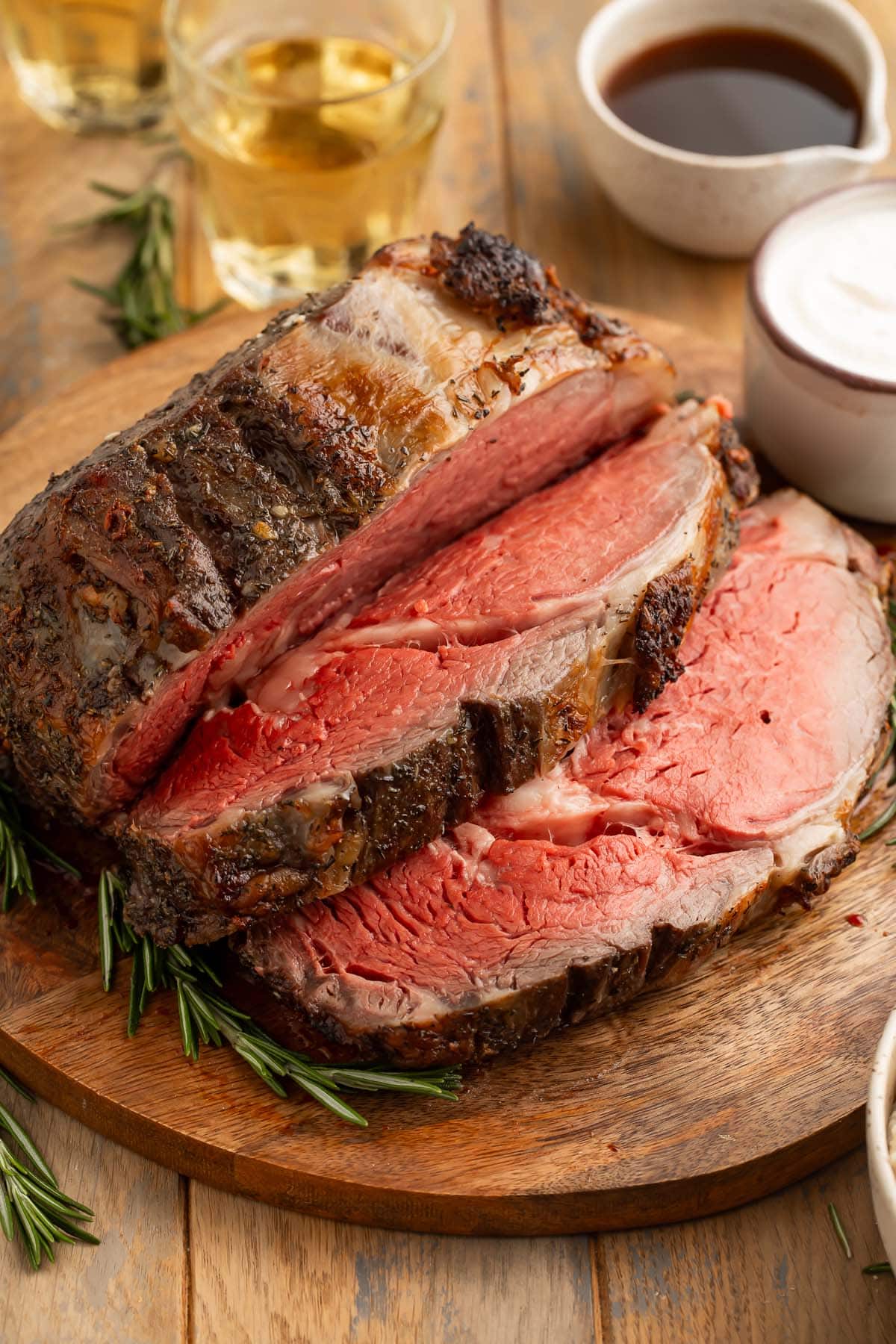
Before You Get Started
- Do you know how much prime rib you need to feed everyone around your table? A good rule of thumb is to plan for 1 pound for every person. Keep in mind that the prime rib is bone-in so a 10 pound rib roast won’t mean 10 pounds of meat!
What I Love About This Recipe
- We love a good prime rib roast here, and this reverse sear prime rib might just be my favorite one yet. The method is absolutely foolproof, and the results are absolutely incredible. Tender and juicy, with an outrageously crisp, flavorful crust. If you’re a “prime rib on Christmas” kind of family, you have to give this a try!
- Reverse searing a standing rib roast takes some time, but it’s more than worth the wait. The low amount of effort required helps, too. It takes roughly 3 hours to roast the prime rib, but that’s 3 hours you can spend readying your sides and desserts!
Cheryl’s Tips
- Look for a standing rib roast that has a good amount of marbling. That marbling is fat, and that fat equals flavor.
- Don’t skip the rest time! Letting the prime rib rest before the reverse sear allows the meat to reabsorb and redistribute the juices, ensuring each bite is perfect. You only need to let the roast rest once, too – no need to rest again after finishing the crust.
- As always, when it’s time to carve the prime rib, make sure you slice the meat against the grain. If you cut parallel to the muscle fibers in the meat, you’ll end up with chewy, tough prime rib.
Making changes to a recipe can result in recipe failure. Any substitutions or variations listed are simple changes that I believe will work in this recipe, but results are not guaranteed.
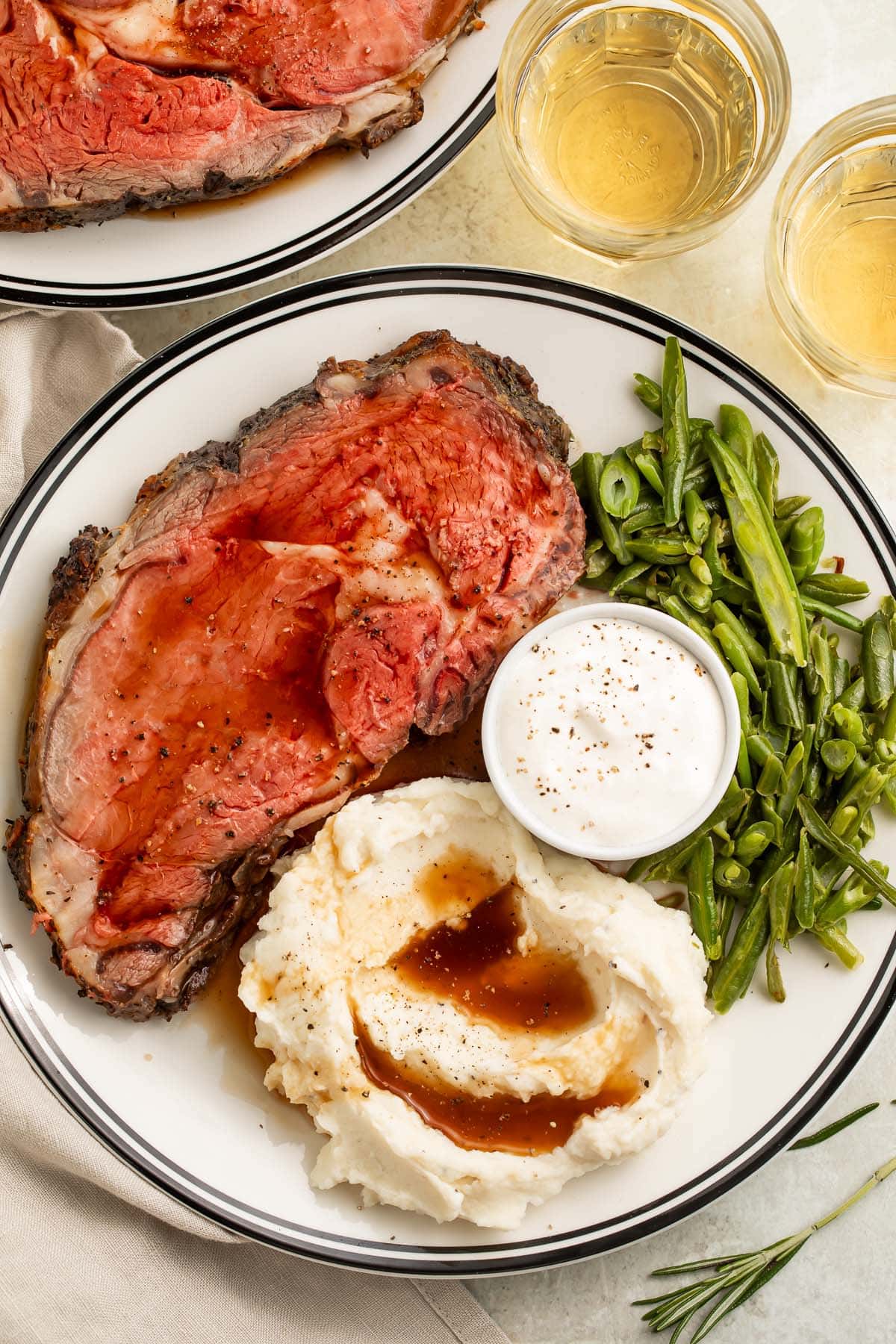
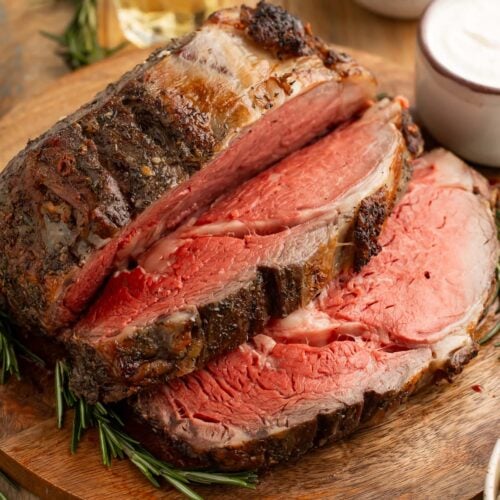
Reverse Sear Prime Rib
Equipment
- 2 small mixing bowls
- 2 whisks
- large roasting pan
- food-safe plastic wrap
- refrigerator
- Oven
- Basting Brush optional
- Aluminum Foil
- internal meat thermometer
- Small saucepan
Ingredients
For the Prime Rib
- 1 10-pound bone-in standing rib roast
- 2 tablespoons kosher salt
- ½ cup butter at room temperature
For the Garlic-Rosemary Crust (Optional)
- 2 tablespoons minced fresh rosemary
- 1 tablespoon minced garlic approximately 5 large cloves
- ground fresh black pepper to taste
For the Jus (Optional)
- 4 tablespoons prime rib drippings
- 4 tablespoons red wine or low-sodium beef broth
- 2 cups low-sodium beef broth
- salt to taste
- ground fresh black pepper to taste
For the Horseradish Sauce (Optional)
- 1 cup full-fat sour cream
- ½ cup full-fat mayonnaise
- 2 tablespoons prepared horseradish
- 1 teaspoon white wine vinegar
- ½ teaspoon salt more or less to taste
Instructions
For the Horseradish Sauce
- Add 1 cup full-fat sour cream, ½ cup full-fat mayonnaise, 2 tablespoons prepared horseradish, 1 teaspoon white wine vinegar, and ½ teaspoon salt to small mixing bowl. Stir ingredients together until well-blended.
- Cover bowl with lid or food-safe plastic wrap and place in refrigerator. Refrigerate at least 1 hour or until ready to serve.
For the Prime Rib
- Place 1 10-pound bone-in standing rib roast in large roasting pan.
- Sprinkle 2 tablespoons kosher salt onto rib roast, covering all sides generously.
- Cover rib roast loosely with food-safe plastic wrap, then place roasting pan in refrigerator. Chill rib roast 8 to 12 hours.
- After chilling, remove roasting pan from refrigerator and uncover. Let rib roast stand 30 minutes or until room temperature.
- Preheat oven to 200° Fahrenheit.
- Add ½ cup butter, 2 tablespoons minced fresh rosemary, 1 tablespoon minced garlic, and ground fresh black pepper to small mixing bowl. Mix ingredients together until well incorporated.
- Spread butter mixture onto rib roast, covering all sides completely.
- Place roasting pan in preheated oven. Roast approximately 3 hours or until internal temperature of rib roast reaches 115° Fahrenheit according to internal meat thermometer. Note: see Notes below for alternate temperatures.
- Once rib roast reaches 115° Fahrenheit internally, carefully remove pan from oven. Tent pan loosely with aluminum foil and let rib roast rest 20 minutes.
- While roast rests, increase oven temperature to 500° Fahrenheit.
- When oven reaches 500° Fahrenheit, uncover roast and return pan to oven. Bake roast 5 to 10 minutes or until well-browned on all sides.
- Once browned, remove pan from oven and set aside while preparing jus.
For the Jus
- While roast rests, place medium saucepan on stovetop over high heat.
- Add 4 tablespoons prime rib drippings, 4 tablespoons red wine, and 2 cups low-sodium beef broth to saucepan. Whisk ingredients until incorporated.
- Bring mixture to boil, then immediately reduce heat under saucepan to medium-low. Simmer mixture 5 minutes.
- After 5 minutes, taste mixture and add salt and ground fresh black pepper as desired. When satisfied with flavor, transfer jus into serving container. Note: if drippings contain any pieces of meat, strain jus through fine mesh sieve before transferring to serving container.
To Serve
- Carve prime rib into slices of desired thickness. Serve prime rib warm with prepared horseradish sauce and jus.
- Go by the internal temperature of the rib roast, not the cooking time. Every oven will behave differently and your oven may cook faster or slower than mine.
- After enjoying your rib roast, use the bones to make your own homemade bone broth!
Internal Temperatures for Desired Doneness
- Rare – Remove prime rib from oven when internal temperature reaches 110° Fahrenheit.
- Medium-Rare – Remove prime rib from oven when internal temperature reaches 115° Fahrenheit.
- Medium – Remove prime rib from oven when internal temperature reaches 120° Fahrenheit.
- Medium-Well – Remove prime rib from oven when internal temperature reaches 130° Fahrenheit.
- Well – Remove prime rib from oven when internal temperature reaches 140° Fahrenheit.
Approximate Information for One Serving
Nutrition Disclaimers
Number of total servings shown is approximate. Actual number of servings will depend on your preferred portion sizes.
Nutritional values shown are general guidelines and reflect information for 1 serving using the ingredients listed, not including any optional ingredients. Actual macros may vary slightly depending on specific brands and types of ingredients used.
To determine the weight of one serving, prepare the recipe as instructed. Weigh the finished recipe, then divide the weight of the finished recipe (not including the weight of the container the food is in) by the desired number of servings. Result will be the weight of one serving.
Did You Make This Recipe?
Tag @40aprons on Instagram and be sure to leave a review on the blog post!
More Holiday Entrées to Impress Your Guests
- Sous Vide Prime Rib with Au Jus
- The Best Lobster Bisque (Ruth’s Chris Copycat Recipe)
- Grilled Spatchcock Turkey with Gravy
- Sous Vide Tri Tip with Easy Chimichurri Sauce
- Easy Air Fryer Whole Chicken with Crispy Skin
- The Best Filet Mignon Recipe Ever with Garlic Herb Compound Butter (Reverse Sear)
- One-Pan Cranberry Rosemary Chicken
- Easy Prime Rib with Au Jus Recipe and Perfect Creamy Horseradish Sauce
- Crispy Chicken Fritta

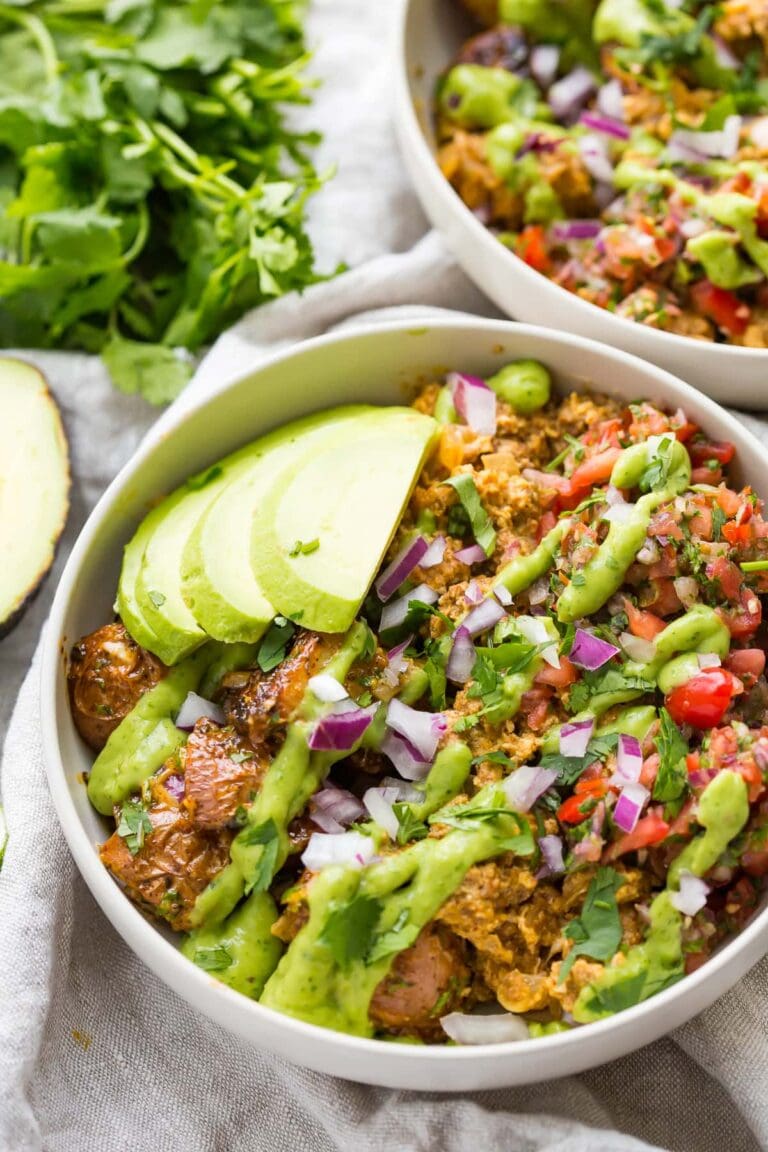
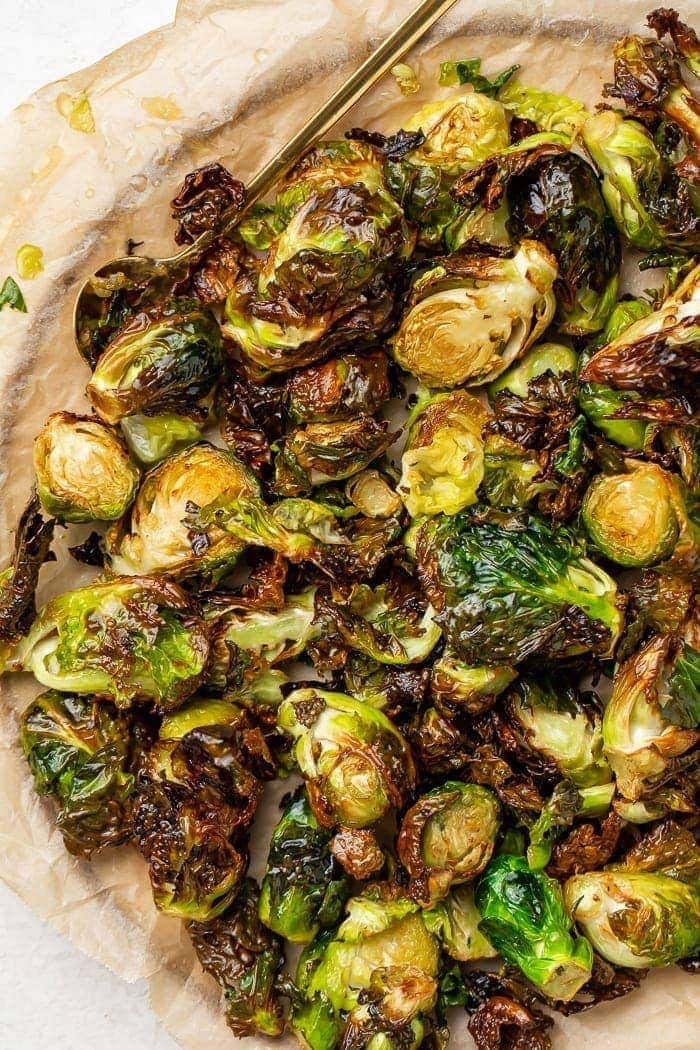

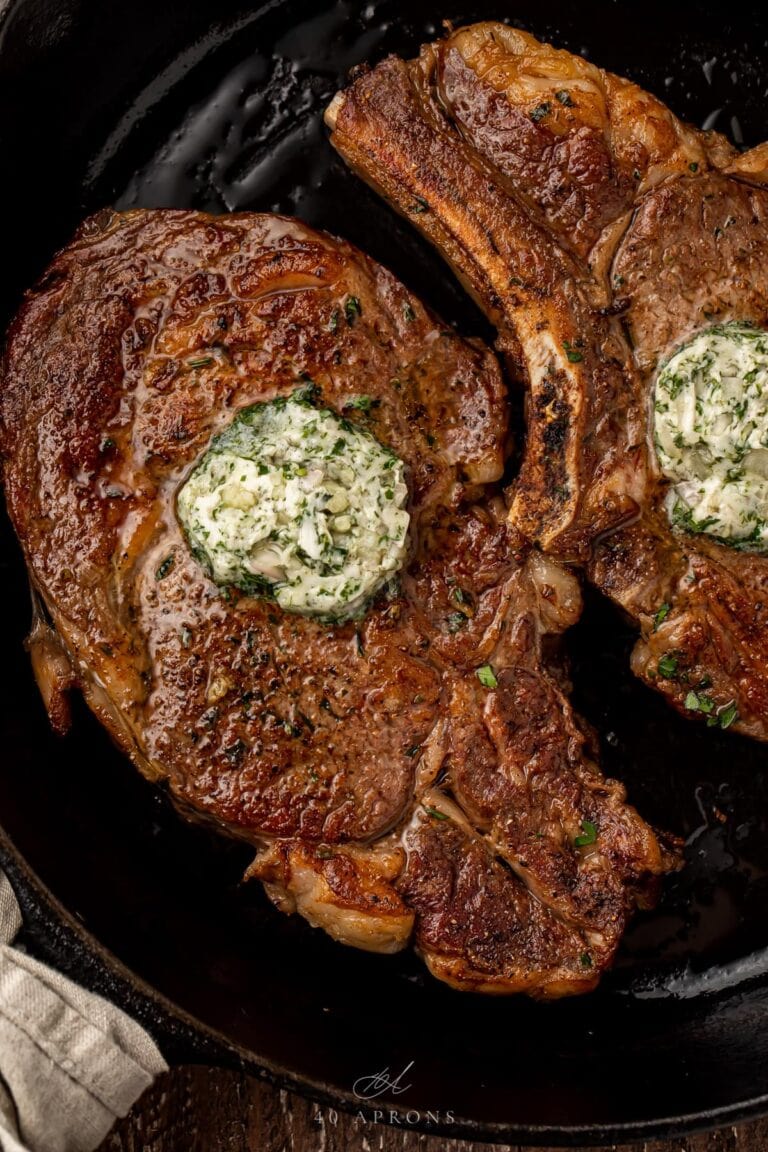










Never Miss A Meal!
New Recipes Straight To Your Inbox
A curated selection of our most recent recipes, delivered straight to your inbox once a week.
Thank you!
You have successfully joined our subscriber list.